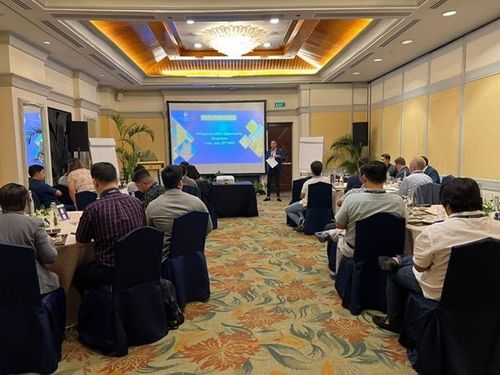USGC: The Philippines shows corn, ethanol, DDGS potential

Pictured, the USGC’s Southeast Asia and Oceania office recently held a Philippine DDGS Opportunity Tour, in which experts from around the world discussed ways to optimize Philippine animal feed rations. / SOURCE: USGC
September 6, 2023
BY U.S. Grains Council
The Philippines is a nation of 110 million people, of which, 55 percent are under 30 years old and 47 percent live in an urban environment, producing a gross domestic product (GDP) of just under $1 trillion. As one of the fastest growing nations by population, the country is also experiencing six to seven percent economic growth year on year.
The United States and the Philippines share a long history, and that legacy can be seen in daily life, from the organization of government to the preference for U.S. produce and fast-food chains. The Philippines boasts a food-centric culture, with fish making up the majority of the diet by volume, followed by poultry. Nonetheless, pork remains a cultural staple as seen in the widely popular dish, ‘lechon’.
Thirty percent of the Philippine population is directly involved in agriculture, making up 11.3 percent of total GDP.
“Both the United States and the Philippines have deep roots in agriculture. This shared foundation and entwined political past presents big opportunities for bilateral trade and investment between the two nations,” said Caleb Wurth, U.S. Grains Council (USGC) regional director for Southeast Asia and Oceania.
Advertisement
As the Philippines’ middle class grows and the economy progresses, the country continues to face systematic policy and supply chain challenges within the agricultural sector. Inefficient farm sizes, high cost of fertilizer and lack of post-harvest storage are tacked onto being a nation of more than 7,000 islands that frequently get hit by typhoons, earthquakes and volcano eruptions.
Partly due to these constraints, the country is short on domestic inputs, while imposing restrictions on imported raw material such as corn. Coupled with outbreaks of African Swine Fever, the Philippines can be a challenging environment for livestock farmers.
Despite these constraints, the Philippine agricultural industry is resilient and has a bright future ahead. Policy makers have taken the first steps to liberalize trade through lowering the tariffs imposed on corn imports within the minimum access volume (MAV).
The Philippines is considering increasing bioethanol usage from 10 to 15 or 20 percent nationwide, opening endless opportunities for rural value-added industry and foreign trade and investment. Through progressive ethanol policy, the Philippines will also lead the region in human health and environmental impact mitigation.
Advertisement
Food production systems in the Philippines are becoming more resilient. This can be seen in the country’s adoption of alternative ingredients such as distillers dried grains with solubles (DDGS), high protein corn co-products and corn fermented protein. As price for base commodities such as corn, wheat and soy continue to rise, U.S. corn co-products become more attractive. The Philippines capitalized on this by importing more DDGS in the first half of marketing year 2022 than was imported in all of 2017. DDGS imports peaked at 281,000 metric tons (MT) in 2020 before the implications of the global pandemic set in; however, import numbers are coming back in turn.
Keeping true to its commitment in the country, the Council recently completed a Philippine DDGS Opportunity Tour, conducting technical information seminars in Cebu and Manila.
Experts from around the world came to discuss ways to optimize Philippine animal feed rations, with an aim to help lower inflation and increase business resiliency. The newly minted Corn Sustainability Assurance Protocol (CSAP), a sustainability platform linking U.S. sustainable farm practices to end user value addition opportunities, was also discussed. The market was also introduced to higher protein corn co-products that are starting to be used in aquafeed globally. More than 110 participants attended the two seminars.
“The Philippine agri-industry is incredibly resilient. Despite weather, energy and input cost challenges, they continue to show up and look for new ways to better their businesses and communities. It is imperative the Council continues to invest here,” Wurth said.
Related Stories
Legislation introduced in the California Senate on June 23 aims to cap the price of Low Carbon Fuel Standard credits as part of a larger effort to overhaul the state’s fuel regulations and mitigate rising gas prices.
The government of Brazil on June 25 announced it will increase the mandatory blend of ethanol in gasoline from 27% to 30% and the mandatory blend of biodiesel in diesel from 14% to 15%, effective Aug. 1.
The U.S. EIA reduced its 2025 and 2026 production forecasts for a category of biofuels that includes SAF in its latest Short-Term Energy Outlook, released June 10. The forecast for 2025 renewable diesel production was also revised down.
The U.S. exported 21,545.9 metric tons of biodiesel and biodiesel blends of B30 and greater in April, according to data released by the USDA Foreign Agricultural Service on June 4. U.S. imports of biodiesel were at 4,417.3 metric tons for the month.
The Iowa Biodiesel Board and Iowa Soybean Association joined Pilot Travel Centers, PepsiCo and Optimus Technologies to celebrate the launch of a new B99 biodiesel pump for fleets at Pilot’s Des Moines travel center.
Upcoming Events










